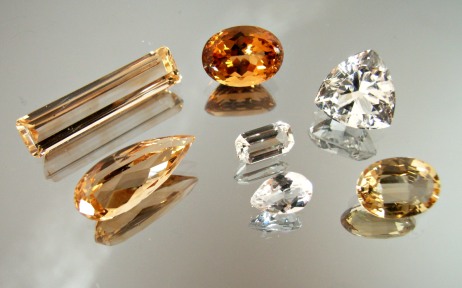 |
 |
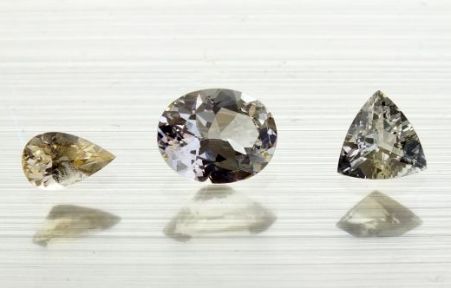 |
| ダンベリー石 (Danburites) 0.95 - 6.93ct Madagascar, Russia, Mexico and Burma |
水晶を伴うダンベリー石結晶 5cm Danburite crystal with quartz Charcas, San Luis Potosi, Mexico Romero Mineralogical Museum, Mexico |
ダンベリー石(Danburites) 0.66 - 1.12ct Tanzania |
ダンベリー石(Danburite)
 |
 |
 |
| ダンベリー石 (Danburites) 0.95 - 6.93ct Madagascar, Russia, Mexico and Burma |
水晶を伴うダンベリー石結晶 5cm Danburite crystal with quartz Charcas, San Luis Potosi, Mexico Romero Mineralogical Museum, Mexico |
ダンベリー石(Danburites) 0.66 - 1.12ct Tanzania |
| 結晶形 (Crystal form) |
結晶系 (Crystal system) |
化学組成 (Composition) |
モース硬度 (Hardness) |
比重 (Density) |
屈折率 (Refractive Index) |
 |
直方晶系 (Orthorhombic) |
CaB2Si2O8 | 7-7½ | 2.97 - 3.03 | 1.630-638 |
名前について(About name)
ダンベリー石の名は最初に発見されたアメリカ、コネチカット州の町ダンベリーに因み1839年に名づけられました。
Danbury はダンバリーと発音したくなりますが、英語の bury (埋める、埋葬する) と同様に u はエと発音されます。
ロンドン郊外の町、Sunbury on Thames, Newbury 等、いずれもサンベリー、ニューベリーと発音されます。
コネチカット州はニューイングランドにありますから、地名の発音もイギリス風となります。
ただし鉱物の danburite の発音の場合は bu の母音がAの口を空けて e と u の中間のような発音になり、人によっては母音が殆ど聞き取れないbの発音にもなりますから日本語で正しく表記することは困難です。
一般にダンブリ石、ダンビュライトと表記されるのはこうした事情を反映していますが名前の由来を鑑みれば、単純にダンベリー石と表記するのが自然です。
因みにコネチカット (connecticut : 結んで切る) 州の名も妙な地名と長年不思議に思っていましたが、これは原住民の発音に由来する当て字と最近ようやく分かりました。
ダンベリーではかつてドロマイト層の中に長石等のペグマタイト鉱物と共に産しましたが、原産地は今は地名のごとく町の地下に埋められてしまっているとのこと。
成因と産状 (Occurence)
産状はペグマタイトやアルプス型の熱水脈、スカルン中の接触変成鉱床、グライゼン等多様な成因があります。 Mindata で調べると世界で70ヶ所余りで産出が報告されています。
が、鉱物標本として市場で見かけるのは近年メキシコのサン・ルイス・ポトシの鉱山からの大きく美しい結晶です。
結晶は形や色合いがトパーズによく似ています。比重や屈折率が異なること、またトパーズのような結晶の底面の完全な劈開がなく、不規則な貝殻上の劈開面を示すため識別は容易です。
マダガスカル、ビルマ、ロシア産の結晶からは金色のインペリアル・トパーズを思わせる宝石がカットされますが、量が少なく全てコレクターの蒐集品となります。本来は無色ですが、金色は不純物として含まれる鉄とチタンの電荷移動による着色と考えられています。
かつて日本からはダイアモンドのイミテーションとしてカットされる程の見事な結晶を産出したことがありました。
Danburite name derives from the first discovery at the town of Danbury, Connecticut, U.S.A., in 1839. There, danburite crystal was discovered in dolomite with feldspar and many pegmatite minerals. The occurences are hydrothermal in pegmatite cavities, ore veins at Alpine-type veins ; metamorphic in skarns and contact metamophosed rocks. Although more than 70 localities are reported world-wide, well formed crystals from San Luis Potosi, Mexico dominates the specimen supply.
A few imperial topaz-like golden crystals from Madagascar, Burma and Russia are facetted mainly for collectors collection.
Danburite is intrinsically colorless. The golden color is attributed to the charge transfer by iron and titanium impurity.
Once Japanese mines produced colorless transparent crystals, which was facetted as dimond simulant.
メキシコのダンベリー石(Mexican danburite)
メキシコのサン・ルイス・ポトシ州チャルカスの銀、銅、亜鉛等の硫化鉱の4つの鉱山から写真の見事な無色、時に淡いピンクの透明な結晶が大量に採れます。無色透明の結晶からは10カラットを越える大きなルースがコレクター向けにカットされます。
Aurora, Bufa, San Bartolo and San Sebastian, four mines of silver, copper and zinc, produce colorless(rarely pale pink) up to 10cm long crystals are collected from sulfied ore veins.
Over 10 carat stones are faceted for collectors purpose.0.95ct 9x5mm 1.08ct 8.5x6mm 5.44ct 19.30x8.68mm San Luis Potosi, Mexico
46x21mm 23mm 30mm 28mm 24mm 27mm 19mm 18mm San Luis Potosi, Mexico
マダガスカルのダンベリー石(Danburite from Madagascar)
5.9ct 19x8.1mm 6.93ct 26.2x6.2mm 25.5x8.6mm 21.1x8.5mm
Sahatamy Valley
Betafo-Antsirabe
20世紀初頭にマダガスカル各地で豊富な鉱物や宝石が発見され始めた頃から宝石質のダンベリー石も報告されていました。
主に島の中央部の Sahatany 渓谷の Antandrokomby やその北側の Betafo-Antsirabe 等のペグマタイト地帯にて50cmを越える大きな結晶が発見され、100カラットを超える特大のルースが研磨されています。
トパーズより僅かに高い屈折率を持ち金色に煌くダンベリー石は知られざる宝石の代表的な例と言えましょう。
知名度が低く一般の宝飾品に使われることはありませんからカラット当たり10ドル程度とコレクターには嬉しい値段です。
While rich mineral and gem resouces were discovered in Madagascar in late 19th to early 20th centuries, gemmy danburites wer reported from various pegmatite zones, mainly in the central islands ; Antanadrokomby and Betafo-Antsirabe are. Huge golden crystals over 50cm yielded over 100 carats faceted stones. Having slightly higher refractive index than topaz, danburite is one of the most attractive gemstones unknown to general public. Thanks to lesser popularity, faceted stones fetch never higher than US$10 per carat.
タンザニアのダンベリー石(Tanzanian Danburite)
 |
 |
 |
| 2.26ct 10.1x8.1mm | 1.12ct 7.6x7.5mm | 0.66ct 8.1x4.9mm |
| Morogoro region, Tanzania | ||
2006年頃、タンザニアのモロゴロ地域にて宝石質のダンベリー石発見の情報がイタリアの鉱物誌に掲載されました。
2008年のツーソン・ショーには合わせて1トンもの様々な品質のダンベリー石の結晶が出品されるほどになりました。
ただし宝石質の結晶は5kg 以下でした。
ダンベリー石は大理石岩盤を貫く2ケ所の急峻な花崗岩ペグマタイト鉱脈から淡緑色のアマゾナイト団塊、黒いドラバイト・ショールと共に発見されます。
このペグマタイトには煙水晶、無数のインクルージョンで亜透明な青みを帯びた紫水晶も採掘されます。
この産地からは最大で22.4 カラットのルースと透明ー黄色ー金色のルースが得られます。
多くの結晶には透明なやや黄色味を帯びたチューブ状のインクルージョンが含まれ、不透明な結晶はカボション・カットされてキャッツ・アイ効果を示すものがあります。
ビルマのダンベリー石(Burma Danburite)
ビルマのモゴクからは宝石質の金色のダンベリー石が採れます。市場でモゴク産の結晶を見かけたことがありませんので産状が分かりませんでした。以前に見た資料ではルビーの漂砂鉱床で発見されるとありました。おそらく間違いではないと思いますが、今回入手した左の写真の結晶は全く磨耗していません。したがって初生鉱床からも宝石質の結晶が採掘されていると考えられます。稀な緑色の石も報告されています。
Mogok, Burma has been the major supplier of golden danburite till 1990, until Madagascar replaced it's position. Occurence seems to be both primary and alluvial deposits. Rare green colored stone is reported too, only from Burma.2.54ct 11.7x8.2mm 稀な緑の石 21.5ct
Rare green stone結晶(Crystals)
26mm & 10mmMogok, Burma
ロシアのダンベリー石(Russian danburite)
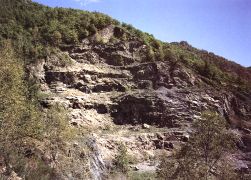 |
 |
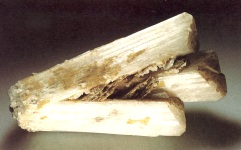 |
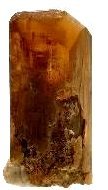 |
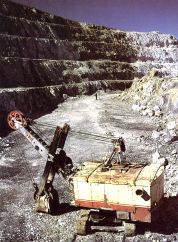 |
||
| 放棄されたダンベリー石鉱山 Abandoned Danburitiy Mine |
21.2x6.3x5cm ex-F.Pough Collection |
18.5cm |
宝石質結晶 Gemmy crystal |
唯一の露天掘り鉱山 Only operating open pit |
||
| Danburitiy Mine | Bor(Boron) Quarry | |||||
| Dal'negorsk, Russia | ||||||
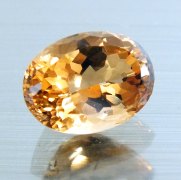 |
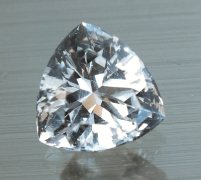 |
| 5.44ct 12.8x9.5cm | 5.84ct 11.7mm |
| Dal'negorsk, Russia | |
日本海に近いロシアのダルネゴルスクの鉱床は1872年に中国人によって発見されました。1887年にロシア領となり町の周囲15km内に合計8つの鉱山が開発され、鉛、亜鉛、硼素、銀、ビスマス、カドミウム、インジウム等が採掘され、現在は4つの鉱山が稼動しています。
閉山となった鉱床も一部は鉱物標本採集用に開放されています。
この地の鉱床は太平洋プレートの沈み込み地帯にあって、ジュラ紀(およそ2億年昔)以降、火山岩や熱水脈の貫入、褶曲や断層等の地殻変動が繰り返えされて160種以上の鉱物が形成されました。
とりわけ最大では家ほどの大きさの空隙内に熱水脈によって成長した水晶、方解石、蛍石、斧石、ダトー石等の巨大な結晶標本が有名です。
ダンベリー石は三畳紀(2.5〜2億年昔)からジュラ紀の石灰岩と石英質の頁岩との堆積に貫入した熱水脈との接触によるスカルン作用によって形成されその名もダンベリー石鉱山と呼ばれて短期間稼動した硼素の露天掘り鉱床からのみ採集されました。
最大では40cmに達する巨大な結晶を産しました。
写真のF.ポー博士のコレクションの結晶はかつて採れた結晶を偲ばせるものです。
The Dal'negorsk mineral deposit, located 35km from the sea of Japan, were discovered in 1872 by the Chinese. In 1887 the Russians settled the region and started mining with 8 mines located within 15km around the town of Dal'negorsk for lead, zinc, bismuth, silver, cadmium, indium and boron. Today four of these mines are operating and some of closed mines are open for mineral specimen collectors.
The geology of the Dal'negorsk region is complex because of repeated plate techtonic events. The oldest rocks in this area are limestones, sandstones and siltsontes of Upper Triassic to Upper Jurassic age. They were pushed into their present position as a result of the subduction under the East Coast of Russia. Overlying the sediments are Cretaceous tuffs. All of these rocks are faulted and are intruded by a series of igneous rocks. Then followed by two series of Tertiary intrusions associated with the boron mineralization. There are many combinations of minerals of over 160 species, of which huge crystals of quartz, calcite, axinite, fluorite, datolite and danburites, etc., grown in the cavities of ancient hydrothermal veins, ranging in size from a few centimeters across to the size of a house.
Danburite has been found only in the Danburitiy mine, which was an abandoned open pit once mined briefly for boron. It occured as transparent, prismatic crystals from several mm in size to large 40cm crystal. A crystal specimen photo of ex-F.Pough collection reminds us of the potentiality of this region.
** F.Pough博士の名前ですが、今まで”パフ”と記載していました。cough (咳) 、rough (荒々しい) 、tough (頑強な、困難な) 等々、多くの同じ綴りの単語がカフ、ラフ、タフと発音されるためです。
ポー博士は今年の4月に99歳で亡くなりましたが、Lapidary Journal 誌 6月号の冒頭の追悼文の中で、編集者達がしばしば博士の文章を "Pough-etry" として "Poe" ポーと発音するとの付記がありました。
実際博士の軽妙で凝った文章は"詩的”と形容するに相応しいものです。
アレクサンドル・フェルスマンと並び、20世紀を代表するアメリカとロシアの鉱物学者がいずれも詩的な文章の達人でもありました。
再び Pough の発音ですが、やはり一般にはパフと発音されます。
New York Times 紙に掲載された追悼文にも同様に発音についての注が付いていたことからもポーの発音が異例であることが伺えます。
何故ポーと発音されるのか調べてみると、Pough の家名は古英語で孔雀を意味する Pawa に由来し、後にPoe, Po Poes , Pow , 等様々な綴りに変わって伝えられたとの事。
現在のフランス語では孔雀は paon (パンと発音される) ですから、おそらく10世紀頃のノーマン・コンクエストの時代に古英語に入った言葉と思われます。
当時のフランス語は古英語の pawa と言う綴りからするとラテン語の pavo (パヴォ) に近い綴りと発音だったと推定されます。
作家の Edgar Allan Poe が同じ家系に属します。
リンクしている"鉱物たちの庭”では流石に正しくポー博士と記載されています。
1958年に開かれたボル(ボロン:硼素)鉱床は現在も年間20万トンの硼素の精製鉱を産していますが、鉱石の30〜45%はダトー石です。
ダンベリー石の60cmもの結晶がここから採集されたと資料にあり、まるで宝石質の結晶の写真もありますが、それは方解石、石英とダトー石から成る仮象であったとのこと。
最近ネット市場に、写真のように数カラットの大きさの無色や金色のダンベリー石のルースが登場しました。ダルネゴルスク産とのことですが、これが新たに採集されたものか、或いは昔の結晶の在庫からカットされたものかは定かではありません。
この地のダンベリー石の中には濃いオレンジー金色の発色のために放射線照射をすることがあるとのことです。
バイカル湖の南東部、モンゴル国境に近いマルハン・ペグマタイト地帯は原生代の火成岩と変成岩に覆われていますが、ジュラ紀に貫入した花崗岩性の200ものペグマタイト鉱床があり、現在そのうち7ヶ所で採掘が行われています。
中でも最も豊穣なモハヴァヤ・ペグマタイト鉱床には無数の晶洞が存在し、トルマリン等のペグマタイト鉱物の結晶が発見されます。
ダンベリー石の細粒で覆われたトルマリンが発見されたり、ある晶洞には共に最大で5cmに達する宝石質のオレンジ色のダンベリー石の結晶が報告されています。
The Bor(Boron) quarry opened in 1958, is the only operating open pit in the area, and is being mined for datolite as a source of boron. The mine now produce 200,000 tons a year of boron concentrate (8 to 10% B2O3) from ore with 30 to 45% datolite. In the Bor open pit danburite is represented by pseodomorphs up to 60cm which proved to be a mixture of calcite, quartz and datolite. In the ancient hydrothermal cavities not filled with andesite, they have been replaced by crystals of quartz and datolite that have the general shape of the danburite. Some danburite of this locality have been irradiated to produce a deep golden orange color.
The Malkhan pegmatites of The Transbaikal region is famous for gem tourmalines. The pegmatites appears to be related to Jurasic granitic plutons that have intruded Proterozoic metamorphic and igneous rocks. At least 200 pegmatites are located within the malkhanskiy district. Of these, seven are currently productive. The most extensive and productive of these is the Mokhovaya pegmatite, which is granitic in compostion and contains adundant miarolitic pockets, which contains various pegmatite minerals, such as gemmy tourmalines.
In some pockets tourmaline is coated with a crust of fine -grained danburitecrystal. A few pockets contain large (up to 5cm) gemmy orange danburite crystals.
その他の産地のダンベリー石(Danburite from other localities)
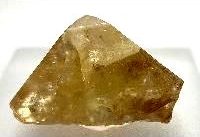 |
 |
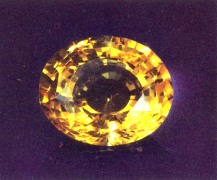 |
 |
| ラモナ産結晶 20x12x12mm Rare danburite from Ramona Little Three Mine, Ramona California |
両端を示す結晶 danburite 40x30x20mm Alto Chapara, Cochabamba Bolivia |
サファイアのようなダンベリー石 11ct Golden sapphire-like Danburite Srilanka |
danburite
11.52ct Nirialla River near Ratnapura Srilanka |
前述の主要な産地の他に世界で70ヶ所ほどから報告されていますが、標本を見かけることも稀です。
カリフォルニアのペグマタイトでは滅多にダンベリー石は採れませんが、写真はスペッサータイン・ガーネットで有名なラモナで採られた貴重な標本です。
ボリビア産のダンベリー石は電気石の新種、ポヴォンドラ電気石と共に赤鉄鉱、細粒の菱苦土石、苦灰石、滑石、カリ長石、石膏、硬石膏、と共に産出します。
ポヴォンドラ石が新種の電気石と認知されるに当たってボリビア・アンデス山中の産地の地質が詳しく調べられ、カンブリア紀或いは先カンブリア紀の硼素とマグネシウムに富む古い蒸発岩の名残が低温で変成作用を受けた中で生成したものと判明しました。
灰色を帯びた不透明な結晶ですが両端を持つほぼ完全な結晶として産出する興味深い標本です。
スリランカはダンベリー石の産地としては全く資料に現れません。
しかし10年に1度程度ですが、大きく美しい結晶が採集され宝石としてカットされます。
写真の金色の大きなルースは最上のゴールデン・サファイアのような煌きをみせる逸品です。
In addition to fore-mentioned localities, more than 70 world localities are reported. Danburite is quite rare in pegmatite zone in California. The specimen from Little Three mine, Ramona is a rare example of this locality.
From new locality of Alto Chapare, Bolivia, danburite is collected from low-temperature metamorphic breccia, originated from Cambrian or Pre-cambrian evaporite, rich with magnesium and boron, in association with new tourmaline specy, povondraite, hematite, fine-grained magnesite and dolomite, talc, K-feldspar, gypsum and anhydrite etc. Although gray colored and translucent, both end terminated crystal form is interesting.
There are no descriptions about Srilankan danburite in any literatures. However, superb facetted stone, such as golden-sapphire like stone in photo is repoted once for 10 years.
日本のダンベリー石(Danburite from Japan)
稀産のダンベリー石ですが、かつて宮崎県の土呂久鉱山と古祖母山を挟んで北側の大分県側の尾平鉱山の錫鉱床からは美しい標本を産しました。
当時の日本では恐ろしく高価で稀少品であったダイアモンドの代用品としてカットされたとあります。
トパーズ並の屈折率ではどんなにがんばってもダイアモンドには見えませんが、カット可能な美晶を産出しただけでも大したもの。
日本産鉱物としては愛媛県市ノ川鉱山産の輝安鉱と並ぶ世界的な結晶で未だに世界の鉱物の資料に名を残しています。ダンベリー石結晶
(Danburite crystals)19 24 20mm宝石質の結晶 25mm
Gem quality danburite宮崎県 土呂久鉱山 Toroku Mine, Miyazaki, Japan